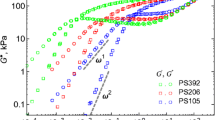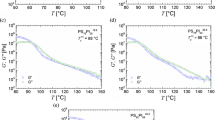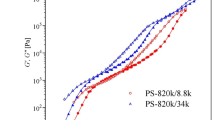Abstract
In the search for a workable mixing rule, use was made of experimental data for complex moduli of melts of narrow molar mass distribution polystyrenes and their homogeneous blends. In the course of this work two basic observations were made as to the nature of the relaxation time spectra of these blends:
-
a)
The relaxation strength (a product of the weight fraction and the plateau modulus) of a component of large molecules is reduced by the presence of shorter molecules, the latter molecules acting like ordinary diluent molecules even if their molar masses are larger thenM c .
-
b)
The relaxation time of a molecule (known from measurements on the respective monodisperse component) is considerably changed by the blending. The width of the distribution of relaxation times, as expected from the known composition of the blend, is significantly reduced.
For both processes approximate empirical equations could be found. It turned out that, after the application of the required modifications, the complex moduli of the components could successfully be added in order to obtain the complex moduli of the blend at circular frequencies characteristic for the flow and rubber transition regions. On the basis of these results one may expect that for the melt of any linear polymer the linear viscoelastic properties can be evaluated with reasonable accuracy from the knowledge of the molar mass distribution.
Similar content being viewed by others

References
Schausberger A, Schindlauer G, Janeschitz-Kriegl H (1983) Rheol Acta 22:550
De Gennes PG (1971) J Chem Phys 55:572
Watanabe H, Sakamoto T, Kotaka T (1985) Macromolecules 18:1436
Graessley WW (1974) Adv Polym Sci 16:3
Ferry JD (1980) Viscoelastic Properties of Polymers, 3rd ed. John Wiley, New York
Doi M, Edwards SF (1978) J Chem Soc, Faraday Transactions II 74:1789, 1802, 1818
Masuda T, Kitagawa K, Inoue T, Onogi S (1970) Macromolecules 3:116
Bersted BH (1979) J Appl Sci 24:671
Bernard DA, Noolandi J (1982) Macromolecules 15:1553
Frank A, Meissner J (1984) Rheol Acta 23:117
Lui TY, Soong DS, Williams MC (1983) J Rheol 27:7
Watanabe H, Kotaka T (1984) Macromolecules 17:2316
Schindlauer G (1984) Doctoral Thesis, Linz University
Schausberger A, Schindlauer G, Janeschitz-Kriegl H (1985) Rheol Acta 24:220
Schindlauer G, Schausberger A, Janeschitz-Kriegl H (1985) Rheol Acta 24:228
Billmeyer FW (1971) Textbook of Polymer Science, 2nd ed, p 189. John Wiley, New York
Curtiss CF, Bird RB (1981) J Chem Phys 74:2016; Bird RB, Saab HH, Curtiss CF (1982) 77:4747 and (1982) J Phys Chem 86:1102
Marrucci G, Titomanlio G, Sarti GC (1973) Rheol Acta 12:269
Knoglinger H, Schausberger A, Janeschitz-Kriegl H (to be published)
Cox WP, Merz EH (1958) J Polym Sci 28:619
Wales JLS (1976) Doctoral Thesis, Delft University
Janeschitz-Kriegl H (1983) Polymer Melt Rheology and Flow Birefringence. Springer, Berlin
Author information
Authors and Affiliations
Rights and permissions
About this article
Cite this article
Schausberger, A. A simple method of evaluating the complex moduli of polystyrene blends. Rheol Acta 25, 596–605 (1986). https://doi.org/10.1007/BF01358168
Received:
Issue Date:
DOI: https://doi.org/10.1007/BF01358168



